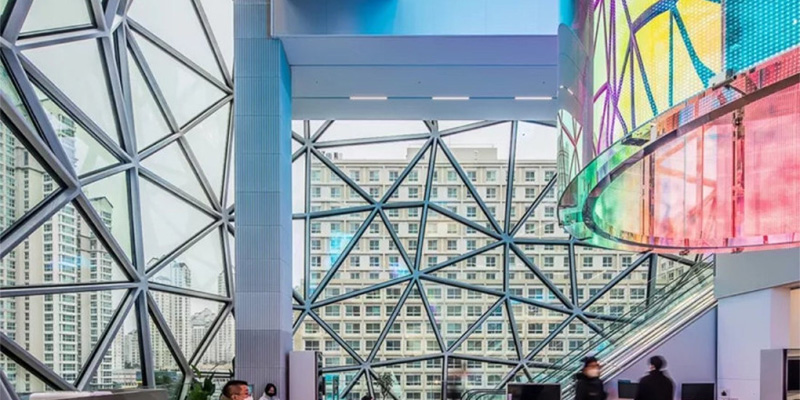EVA/PVB
What is EVA film?
EVA stands for Ethylene Vinyl Acetate. EVA is used in the film form.
EVA film is available with clear, white and many different colours. It contains no plasticizer. It is always packed in roll form. The outstanding adhesive EVA film is non-sticky and its surface is smooth.
EVA film is always used as an interlayer sandwiched in between two pieces of glass or plastic sheet.
Available Thickness:
- 0.25 mm
- 0.38 mm
- 0.76 mm
- 1.14 mm
- 1.52 mm
The advantages of EVA film are,
- High tensile strength
- Excellent transparency
- Outstanding adhesion
- UV protection
- Sound barrier
- Good temperature withstanding
- Water proof
- High wind resistance
- Humidity durable
- Long-term reliable
EVA could also be used for aesthetics, design, art and view control.
If sophisticated design pattern for decorative purpose is mostly concerned, a piece of design film could be put together with the EVA films in between two pieces of glass or plastic sheet. There are numerous selection of design pattern film, for example, PET, silk, metal mesh, paper, fiberglass, fabric, and cloth etc. EVA film bonds very well with many different types of materials at outstanding compatibility.
EVA film for adjusting of light transmission by means of PDLC film.
PDLC stands for polymer dispersed liquid crystal. It consists of thin layer of liquid crystal sealed between two pieces of PET film. It is connected to a power. When there is no electricity, it is opaque. When there is, it becomes transparent. The PDLC film is always sandwiched in between two pieces of glass or plastic sheet with EVA film as the encapsulation material.
Sometimes, it is know as smart glass, intelligent glass, magic glass, privacy glass, switchable glass, electronic conductive glass, color changeable glass, etc.
It could be used for window and door, conference room, hospital, school, hotel and function room etc. Another area of widely applied is advertising and promotional activities. The video or picture is projected onto the glass or plastic sheet with interior PDLC film.
EVA film for photovoltaic purpose
Due to enormous increasing demand of green energy in recent years, photovoltaic becomes one of the most important technology substituting traditional fossil fuel energy. The most popular photovoltaic technology is to use two pieces of ultra clear roll glass laminated with silicon wafer-based to form photovoltaic panel or solar cell. After numerous experiments, EVA film is selected to be the most optimum material for the encapsulation and it is almost monopoly in the solar cell market as the most operating-friendly and cost effective material for solar battery glass encapsulation.
Anti-UV EVA film
By compounding with anti-UV additives, EVA film does not become yellowish after years of long exposure to sunlight. Meanwhile, it can prevent the building interior from aging or color fading, for example, carpet, wall painting, wall paper, furniture and any kinds of stuff close to the window and door.
Application of EVA laminated glass
The application could be infinite. The abundance supplies of a great many choices of design interlayer such as silk, fabric, paper and metal mesh etc with combination of a wide variety of different colors, transparent, translucent or opaque of EVA film could lead to numerous aesthetics and visual effects.
PVB Laminated Glass
Polyvinyl butyral (or PVB) is a resin mostly used for applications that require strong binding, optical clarity, adhesion to many surfaces, toughness and flexibility. It is prepared from polyvinyl alcohol by reaction with butyraldehyde. The major application is laminated safety glass for automobile windshields.
PVB Laminated glass is manufactured by permanently bonding one or more polyvinyl butyral (PVB) interlayer between sheets of clear, coated or tinted glass under heat and pressure. Laminated glass can incorporate various combinations of clear and tinted glass, transparent or coloured interlayers, as well as a range of high performance coatings.
The raw glass is scrubbed clean to remove any impurities, after which the first sheet of quality float glass is fed along the laminating line. A PVB interlayer is drawn over the first sheet of glass and a second sheet of glass is then placed on top of the PVB to create a 'sandwich'. This 'sandwich' passes through a specialised press and heating process which removes most of the air and effectively fuses the three items.
The laminated sheets are then stacked in a specific configuration for loading into an autoclave. Finished laminated sheets are stacked in a dedicated laminates warehouse.
Available Thickness:
- 0.38 mm
- 0.76 mm
- 1.14 mm
- 1.52 mm
Core Benefits of Laminated safety glass:
- Penetration Resistance – more difficult to break through
- Safety – Glass shards are held together by the interlayer
- Sound Reduction – Reduces transmission of sound through the glass
- UV Protection – Prevents fading of furniture and fabrics




